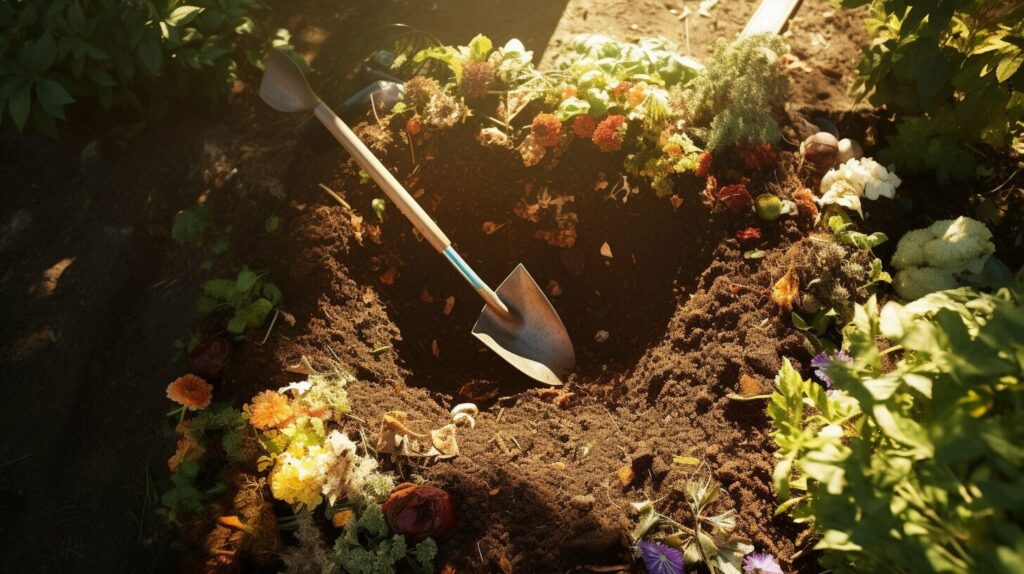Are you looking for a sustainable and efficient way to dispose of your organic waste? Look no further than pit composting. This eco-friendly technique allows you to convert kitchen and garden waste into nutrient-rich compost through natural decomposition. With pit composting, you can not only reduce the amount of waste sent to landfills but also promote sustainable practices in your own backyard or outdoor space.
Pit Composting Benefits:
- Pit composting is a controlled, aerobic process that converts organic materials into compost.
- It can be done in a backyard or outdoor setting using a pit or bin.
- Pit composting reduces waste sent to landfills and promotes sustainable practices.
- The process involves layering organic waste and maintaining the right conditions for decomposition.
- Compost generated from pit composting can be used to enhance soil fertility in gardens and yards.
Read This Blog Post To Understand More About The Different Types Of Compost
Understanding How Pit Composting Works
Pit composting is a natural and efficient method of decomposing organic waste to create nutrient-rich compost. This process, known as aerobic composting, relies on the activity of microorganisms that feed on organic materials and break them down into compost. To understand how pit composting works, let’s take a closer look at the composting process.
Organic Waste Decomposition
In pit composting, organic waste such as vegetable scraps, fruit peels, and yard trimmings is placed in a pit or bin. These materials are rich in nitrogen and carbon, which are essential for successful decomposition. The microorganisms responsible for composting require oxygen to thrive, making pit composting an aerobic process.
As the organic waste decomposes, the microorganisms produce heat, which raises the temperature inside the compost pit. This elevated temperature accelerates the decomposition process and helps break down the organic waste into compost.
The Composting Process
To facilitate the composting process in a pit, it is crucial to maintain the correct conditions. This includes maintaining a proper balance of carbon-rich materials, known as browns, and nitrogen-rich materials, called greens. Browns include items like dried leaves, straw, and wood chips, while greens consist of fresh grass clippings, kitchen scraps, and plant trimmings.
In addition to the right balance of browns and greens, proper moisture levels and airflow are crucial for successful pit composting. The compost pile should be moist, similar to a wrung-out sponge, to provide the necessary moisture for the microorganisms. Turning the compost pile regularly helps promote airflow and enhances the decomposition process.
Over time, the microorganisms in the compost pit break down the organic waste, converting it into nutrient-rich compost. This compost can then be used to improve soil fertility in gardens, flower beds, and vegetable patches, enhancing plant growth and promoting sustainable gardening practices.
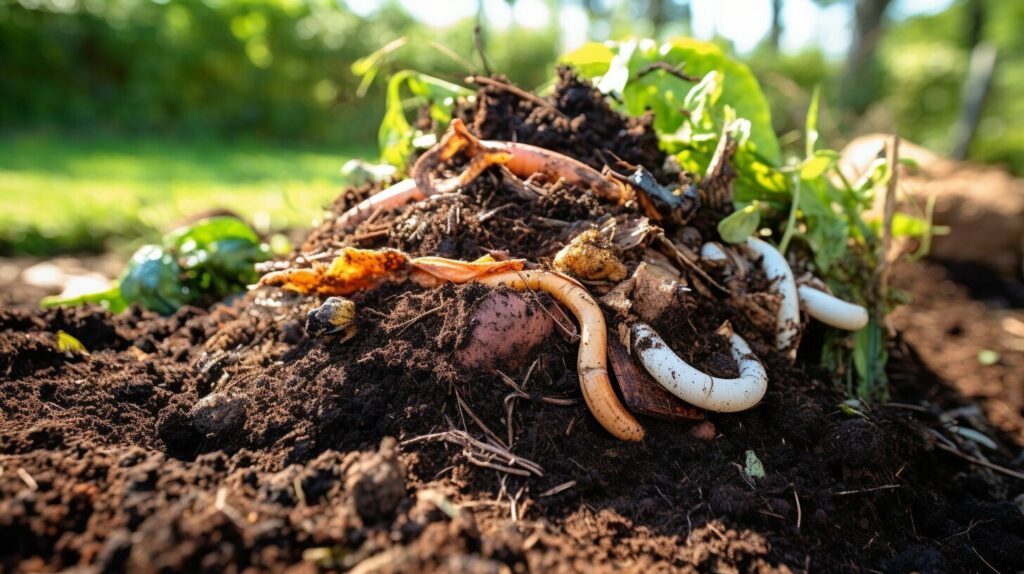
By understanding how pit composting works, you can effectively harness the power of decomposition to transform your organic waste into valuable compost. This sustainable waste disposal method not only reduces the amount of waste sent to landfills but also helps create nutrient-rich soil amendments for a greener and healthier garden.
Choosing the Right Site for Your Compost Pit
When it comes to setting up a compost pit, selecting the right location is crucial for successful pit composting. The site you choose in your backyard or outdoor space can significantly impact the effectiveness of your composting efforts. Here are some key factors to consider:
- Good drainage: Ensure that the site has proper drainage to prevent waterlogging, which can hinder the decomposition process.
- Easy access: Select a location that is easily accessible for adding organic waste and turning the compost pile.
- Nearby water source: Having a water source nearby makes it convenient for maintaining the right moisture level in the compost pile.
- Avoid obstacles: Avoid placing the compost pit against a fence or near utility lines to avoid any potential issues.
By taking these factors into account, you can create an optimal environment for your compost pit, allowing for efficient decomposition and nutrient-rich compost production.
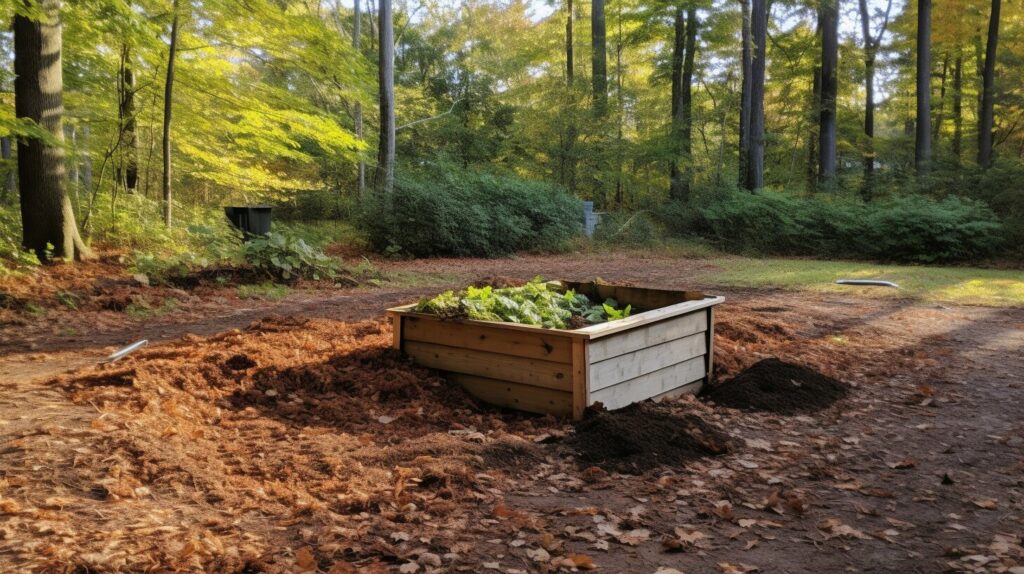
Benefits of Choosing the Right Site for Your Compost Pit
Proper site selection for your compost pit offers several benefits:
- Improved composting process: A well-chosen site promotes ideal conditions for decomposition, such as good airflow and moisture control.
- Reduced maintenance: By selecting a suitable site, you can avoid common issues like excess moisture or foul odors, minimizing the need for corrective measures.
- Convenience: Easy access and nearby water sources make it more convenient to add organic waste and maintain the compost pile.
- Increased compost quality: When the compost pit is located in an optimal location, the compost produced is more likely to be of higher quality, with enhanced nutrient content.
Choosing the right site for your compost pit sets the foundation for successful pit composting and ensures that you can reap the full benefits of this eco-friendly waste disposal method.
Step by Step Pit Composting:Digging to Filling
Pit composting is a straightforward process that can be easily done in your backyard or outdoor space. Let’s take a look at the step-by-step process of pit composting:
Digging the Pit
The first step in pit composting is to dig a pit of the appropriate size and depth. A pit that is approximately 1 foot deep, 2 feet wide, and 3 feet long is suitable for a household of 5-6 members. Ensure that the pit is well-drained and has easy access for adding and turning the compost.
Filling the Pit
Once you have dug the pit, it’s time to start filling it with organic waste. Use a variety of materials such as fruit and vegetable scraps, dry leaves, grass clippings, and small branches. It’s important to layer the materials like a lasagna, alternating between carbon-rich browns (such as dry leaves) and nitrogen-rich greens (such as fruit and vegetable scraps).
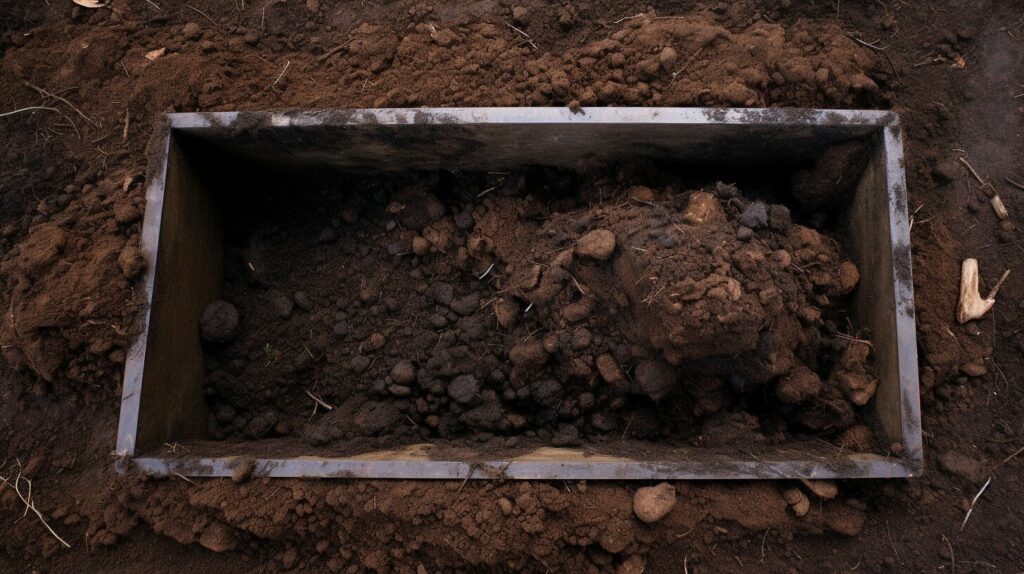
Maintaining the Compost Pile
To ensure proper decomposition, it’s important to maintain the compost pile. Make sure the pile is damp, but not waterlogged, to provide the ideal environment for microorganisms to break down the organic waste. Regularly turn the pile to promote aeration and mix the materials. This will help speed up the decomposition process and prevent any foul odors from developing.
Remember to avoid adding meat, dairy, or greasy foods to the compost, as they can attract pests and create unpleasant smells. Stick to plant-based materials for a healthy and odor-free compost pile.
Summary
In summary, pit composting involves digging a pit, filling it with a combination of carbon-rich browns and nitrogen-rich greens, and maintaining the compost pile by keeping it damp and regularly turning it. By following these simple steps, you can turn your organic waste into nutrient-rich compost that can be used to improve your garden and reduce waste sent to landfills.
Pit Composting Benefits
Pit composting offers a multitude of benefits for both the environment and gardeners. By recycling organic waste through pit composting, we can contribute to sustainable practices and make a positive impact.
“Composting is the most powerful tool in the world against climate change.” – Compostory
One of the major advantages of pit composting is the reduction in waste sent to landfills. Organic waste makes up a significant portion of household trash, and by composting it, we can divert it from ending up in landfills where it would contribute to greenhouse gas emissions. Instead, we harness the power of decomposition to transform waste into nutrient-rich compost that can be used to enrich our soil and support healthy plant growth.
Composting also promotes soil enrichment. The nutrient-rich compost produced through pit composting enhances soil fertility, improving its ability to retain moisture and nutrients. This, in turn, creates a healthier environment for plants to thrive, ultimately leading to increased crop yields and more beautiful gardens.
| Benefits of Pit Composting | Explanation |
|---|---|
| Reduces waste sent to landfills | By composting organic waste, we divert it from the landfill, reducing greenhouse gas emissions and environmental pollution. |
| Enhances soil fertility | The compost produced enriches the soil, improving its structure, moisture retention, and nutrient availability for plants. |
| Reduces the need for chemical fertilizers | By using compost, we can reduce our reliance on synthetic fertilizers, minimizing their environmental impact. |
| Promotes sustainable gardening practices | Pit composting encourages the use of natural, organic methods, promoting a healthier and more sustainable approach to gardening. |
| Cost-effective and easily implemented | Pit composting requires minimal equipment or expertise, making it accessible to a wide range of gardeners. |
Furthermore, pit composting reduces the need for chemical fertilizers. The compost we produce is rich in nutrients, allowing us to minimize our reliance on synthetic fertilizers that can harm the environment. By opting for natural, organic compost, we can promote a more sustainable approach to gardening.
Pit composting is not only environmentally friendly and cost-effective, but it’s also easy to implement in residential settings. With just a small pit in your backyard or outdoor space, you can recycle your organic waste and contribute to soil enrichment. Start pit composting today and unlock the many benefits it has to offer.

Pit Composting vs. Traditional Composting
When it comes to composting methods, pit composting and traditional composting have their similarities and differences. Let’s take a closer look at how these two methods compare and what sets them apart.
Pit Composting
Pit composting is a simple and accessible method that requires minimal equipment and expertise. It involves digging a pit in your backyard or outdoor space and filling it with organic waste, such as food scraps and yard trimmings. The materials break down over time, aided by natural decomposition processes and microorganisms.
Pit composting is a cost-effective method that can be easily implemented in residential settings.
One of the advantages of pit composting is that it reduces the risk of attracting pests and rodents, as the compost is contained within the pit. Additionally, this method is suitable for areas with limited space, as it doesn’t require a large compost bin or specialized equipment. It’s a great option for those who want to compost on a smaller scale and make efficient use of their organic waste.
Traditional Composting
Traditional composting methods, such as compost bins or vermiculture (worm composting), offer their own set of benefits. These methods typically involve using a container or bin to hold the compost materials and facilitate the composting process. Compost bins can come in various sizes and designs, allowing for more control over the composting environment.
Traditional composting methods may be more suitable for urban areas with limited space.
With traditional composting, you can achieve faster decomposition and have more control over the composting process. The use of compost bins allows for easier turning and monitoring of the compost pile, resulting in quicker and more efficient compost production. Traditional composting methods are also well-suited for urban areas where space may be limited, as they can be adapted to fit smaller outdoor spaces or even indoor settings.
| Pit Composting | Traditional Composting | |
|---|---|---|
| Equipment and Expertise | Minimal | May require composting bins or specialized equipment |
| Pest Control | Reduced risk as compost is contained within the pit | May attract pests if not properly managed |
| Space Requirement | Suitable for smaller outdoor spaces | Can be adapted to fit various spaces (indoor or outdoor) |
| Composting Speed | Slower decomposition process | Faster decomposition with more control |
| Scalability | Suitable for small-scale composting | Allows for larger-scale composting |
Both pit composting and traditional composting methods have their advantages and can be effective ways to convert organic waste into nutrient-rich compost. The choice between these methods depends on factors such as space availability, desired composting speed, and personal preferences. Ultimately, the goal of both methods is to reduce waste, improve soil fertility, and promote sustainable practices.
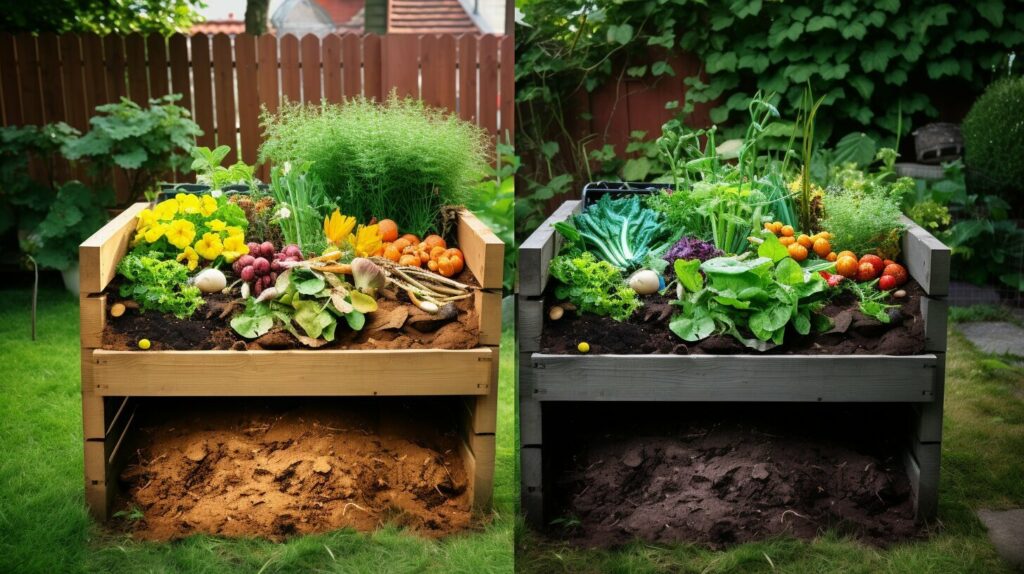
Pit Composting Troubleshooting and Maintenance
To maintain a successful pit composting system, it is important to monitor and address any issues that may arise. Common problems include foul odor, excessive moisture, or slow decomposition. These issues can typically be resolved by adjusting the carbon-to-nitrogen ratio, adding more browns or greens, and turning the compost pile regularly to improve aeration. It is also essential to avoid adding meat, dairy, or greasy foods to the compost, as they can attract pests and lead to unpleasant odors.
One of the key factors in maintaining a healthy composting system is maintaining the right balance of carbon-rich browns and nitrogen-rich greens. The carbon-to-nitrogen ratio should ideally be around 30:1. If you notice that your compost pile has a foul odor, it may be an indication that the pile is too wet or that there is an imbalance in the carbon-to-nitrogen ratio. To rectify this, you can add more browns, such as dried leaves or shredded newspaper, to absorb excess moisture and balance the ratio.
Another common issue in pit composting is slow decomposition. If your compost pile is taking longer than usual to break down, it may be due to insufficient aeration. Turning the compost pile regularly helps to introduce oxygen, which speeds up the decomposition process. Aim to turn the pile every 2-3 weeks using a pitchfork or shovel. This will also help distribute the moisture and nutrients evenly throughout the pile, ensuring that the composting microorganisms have access to everything they need to thrive.
Lastly, it is important to be mindful of what you add to your compost pile. Avoid adding meat, dairy, or greasy foods, as they can attract pests and create unpleasant smells. Stick to vegetable and fruit scraps, coffee grounds, tea leaves, and yard waste. It’s also a good idea to shred or chop the organic materials into smaller pieces. This will help speed up the decomposition process and ensure that all the materials break down uniformly.
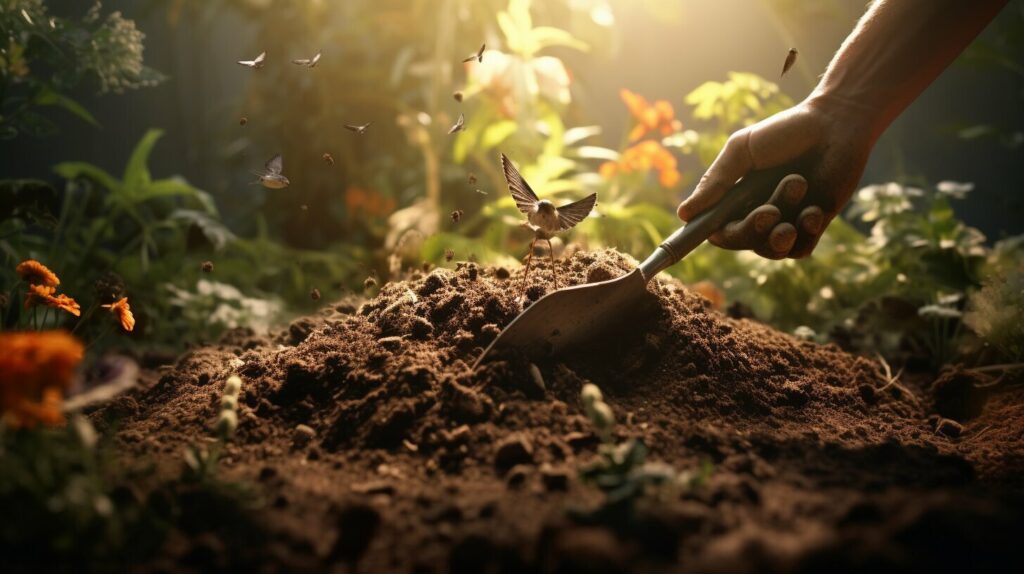
Common Composting Issues and Solutions
| Issue | Solution |
|---|---|
| Foul odor | Add more browns, such as dried leaves or shredded newspaper, to balance the carbon-to-nitrogen ratio and absorb excess moisture. |
| Excessive moisture | Add more browns and turn the compost pile regularly to improve aeration and moisture distribution. |
| Slow decomposition | Turn the compost pile regularly to introduce oxygen and speed up the decomposition process. |
| Attracting pests | Avoid adding meat, dairy, or greasy foods to the compost pile. |
By following these troubleshooting tips and practicing regular maintenance, you can ensure that your pit composting system operates smoothly and efficiently. Remember to assess your compost pile regularly, make adjustments as needed, and enjoy the process of turning waste into nutrient-rich compost for your garden.
Using Compost in Your Garden and Yard
Compost, the nutrient-rich result of pit composting, is a valuable resource for your garden and yard. Its natural properties make it an effective soil amendment that enhances soil fertility and structure. By incorporating compost into your gardening practices, you can create a healthy and thriving outdoor space. Here are some ways to utilize compost in your garden and yard:
1. Amending Soil: Spread a layer of compost over your garden beds or vegetable patches before planting. This enriches the soil with essential nutrients, such as nitrogen, phosphorus, and potassium, promoting healthy plant growth and abundant yields. It also improves soil structure, allowing for better water retention and root development.
2. Mulching: Use compost as a natural mulch around trees, shrubs, and flowers. Apply a thin layer of compost around the base of plants to conserve moisture, suppress weed growth, and regulate soil temperature. As compost breaks down, it gradually releases nutrients, providing a slow-release fertilization to your plants.
3. Lawn Care: Spread a thin layer of compost over your lawn and rake it into the grass. This improves the soil quality, encourages deeper root growth, and enhances the overall health of your lawn. Compost can also help prevent soil compaction and reduce the need for synthetic fertilizers or chemical treatments.
4. Compost Tea: Create a compost tea by steeping compost in water. This nutrient-rich liquid can be used as a foliar spray or soil drench to deliver beneficial microorganisms and nutrients directly to your plants. Compost tea helps strengthen plant defenses, improve nutrient absorption, and enhance overall plant health.
“Compost is like a superfood for your garden. It improves soil fertility, structure, and water-holding capacity, resulting in healthier plants and higher yields.” – Gardening Expert
| Plant Type | Compost Application |
|---|---|
| Vegetable Garden | Mix compost into the soil before planting. Top-dress with compost throughout the growing season. |
| Flower Beds | Incorporate compost into the planting holes and apply as a mulch around the base of the plants. |
| Trees and Shrubs | Spread compost around the root zone, avoiding direct contact with the trunk or stems. |
| Lawn | Apply a thin layer of compost and rake it into the grass for improved soil fertility. |
As you can see, compost utilization offers multiple benefits for your garden and yard. It enriches the soil, promotes plant health, and reduces the need for chemical fertilizers. So start incorporating compost into your gardening routine and watch your plants thrive!

Tips for Successful Pit Composting
When it comes to successful pit composting, there are a few key tips and practices to keep in mind. By following these guidelines, you can ensure that your composting efforts yield nutrient-rich compost and a thriving composting system.
- Chop organic waste into small pieces: Before adding organic waste to your compost pit, it’s important to chop it into smaller pieces. This helps to speed up the decomposition process and ensures that the materials break down more efficiently.
- Maintain a proper balance of browns and greens: A successful compost pile requires a balance of carbon-rich browns and nitrogen-rich greens. Browns include items such as dried leaves, twigs, and straw, while greens consist of food scraps and grass clippings. Aim for a ratio of roughly 3 parts browns to 1 part greens.
- Keep the compost pile moist but not waterlogged: Moisture is an essential component of successful composting. To promote decomposition, keep your compost pile moist, similar to the dampness of a wrung-out sponge. Be careful not to overwater, as this can lead to an overly wet pile that may become anaerobic and produce unpleasant odors.
- Turn the pile regularly: Turning the compost pile helps to aerate it and distributes oxygen to the microorganisms responsible for decomposition. Aim to turn the pile every 1-2 weeks, or whenever the internal temperature drops below 100°F (38°C). This process helps to accelerate the composting process and ensures even decomposition.
- Avoid adding animal products or treated wood: While a wide range of organic materials can be composted, it’s important to avoid adding animal products (such as meat or dairy) or treated wood to your compost pile. These materials can attract pests and may not break down properly.
By following these tips, you can create a thriving pit composting system that generates nutrient-rich compost for your garden and reduces waste sent to landfills. Remember to monitor your compost pile regularly for temperature, moisture, and odor, and make adjustments as needed. With a little care and attention, you’ll soon be reaping the benefits of successful pit composting.
| Composting Tip | Description |
|---|---|
| Chop organic waste into small pieces | By chopping organic waste into smaller pieces, you speed up the decomposition process and ensure efficient breakdown of materials. |
| Maintain a proper balance of browns and greens | A successful compost pile needs a balance of carbon-rich browns and nitrogen-rich greens. Aim for a ratio of 3 parts browns to 1 part greens. |
| Keep the compost pile moist but not waterlogged | Maintain the moisture level in your compost pile similar to that of a damp sponge. Avoid overwatering to prevent anaerobic conditions and odors. |
| Turn the pile regularly | Regularly turning the compost pile helps to aerate it and distribute oxygen, accelerating the decomposition process. |
| Avoid adding animal products or treated wood | To prevent pests and ensure proper breakdown, refrain from adding animal products or treated wood to your compost pile. |
Check Out The Below Blog Posts For More Information About Composting
Conclusion
In conclusion, pit composting is a simple and effective method for managing organic waste in an eco-friendly manner. By converting kitchen and garden waste into nutrient-rich compost, we can reduce the amount of waste sent to landfills and contribute to a healthier environment.
Not only does pit composting help in waste disposal, but it also provides valuable benefits for our gardens and yards. The compost generated from pit composting acts as a natural soil amendment, improving soil fertility, moisture retention, and nutrient availability. By using compost, we can enhance plant growth, control soil erosion, and reduce the need for chemical fertilizers, thus promoting sustainable gardening practices.
With the right site selection and maintenance, anyone can successfully implement pit composting. It requires minimal equipment and expertise, making it accessible to a wider range of people. By following a few simple steps, such as maintaining the right balance of carbon-rich browns and nitrogen-rich greens, ensuring proper moisture levels, and regular turning of the compost pile, we can achieve a thriving composting system.
Start pit composting today and make a positive impact on the planet. By reducing waste, enriching our soil, and promoting sustainable practices, we can contribute to a greener and more sustainable future for ourselves and future generations.
FAQ
What is pit composting?
Pit composting is a controlled, aerobic process that converts organic materials into nutrient-rich compost through natural decomposition in a pit or bin.
How does pit composting work?
Pit composting involves microorganisms feeding on organic materials, breaking them down into compost through aerobic decomposition.
How do I choose the right site for my compost pit?
Choose a location with good drainage, easy access, and a nearby water source, while avoiding fences or utility lines.
What are the steps involved in pit composting?
The steps include digging a pit, filling it with organic waste in alternating layers, ensuring moisture and turning regularly to promote decomposition.
What are the benefits of pit composting?
Pit composting reduces waste sent to landfills, improves soil fertility, reduces the need for chemical fertilizers, and promotes sustainable gardening practices.
How does pit composting differ from traditional composting methods?
Pit composting requires minimal equipment and reduces the risk of attracting pests and rodents compared to other methods like compost bins or vermiculture.
How do I troubleshoot and maintain my compost pit?
Common issues include foul odor, excessive moisture, or slow decomposition, which can be resolved by adjusting the carbon-to-nitrogen ratio and turning the pile regularly.
How can I use compost in my garden and yard?
Compost can be spread on flower beds, vegetable gardens, or lawns to improve soil structure, moisture retention, and nutrient content.
What tips can you provide for successful pit composting?
Chop organic waste into small pieces, maintain a proper balance of browns and greens, keep the pile moist, turn it regularly, and avoid adding certain materials like meat or treated wood.

